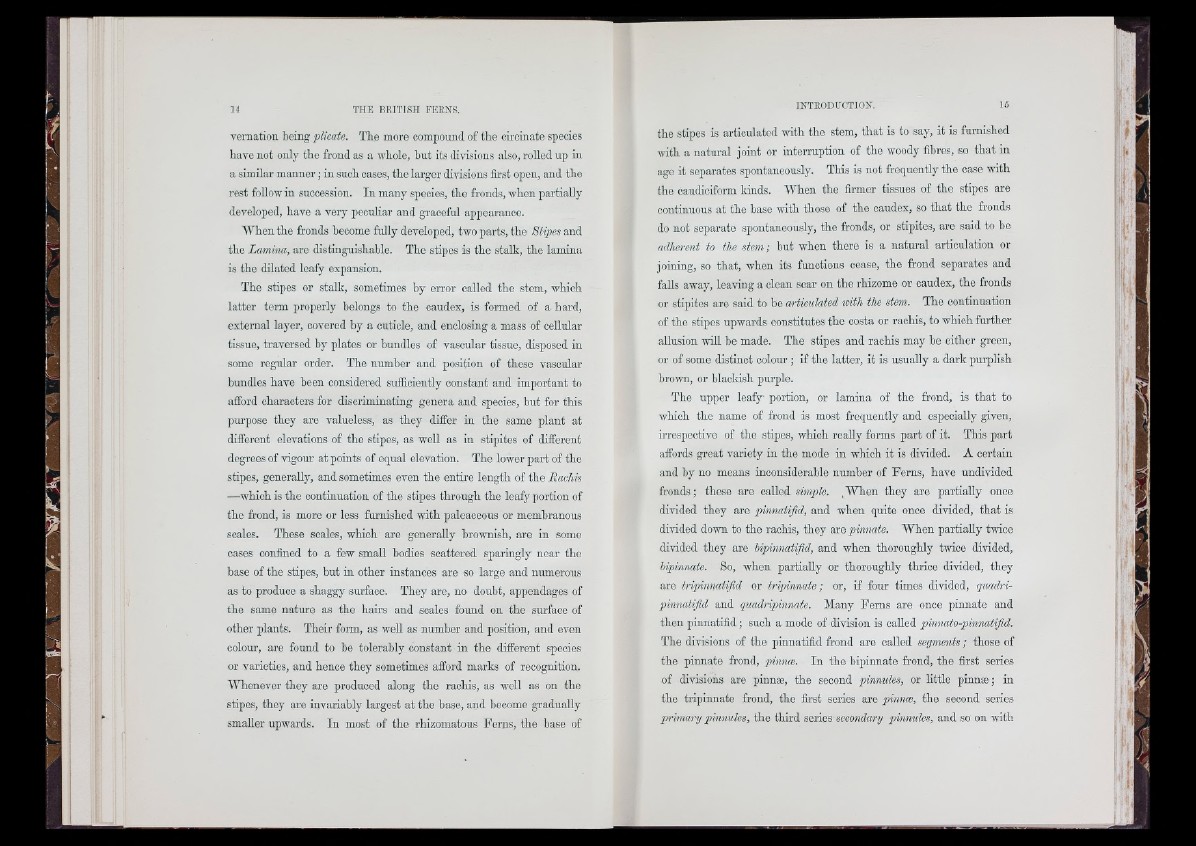
vernation hwxg pilicato. Tlic moro compound of the circinate species
have not only tho frond as a whole, but its divisions also, rolled up in
a similar manner; in such cases, the larger divisions first open, and the
rest follow in succession. In many species, tho fronds, when partially
developed, have a very peculiar and graceful appearance.
"Wien the fronds become fully developed, two parts, tho Stipes and
the Lamina, aro distinguishable. The stipes is the stalk, the lamina
is the dilated leafy expansion.
The stipes or stalk, sometimes by error called the stem, which
latter term properly belongs to tho caudex, is formed of a hard,
external layer, covered by a cuticle, and enclosing a mass of cellular
tissue, traversed by plates or bundles of vascular tissue, disposed in
some regular order. The number and position of these vascular
bundles have been considered sufficiently constant and important to
afford characters for discriminating genera and species, but for this
purpose they are valueless, as they differ iu the same plant at
different elevations of the stipes, as well as in stipites of different
degrees of vigour at points of equal elevation. The lower part of the
stipes, generally, and sometimes even the entire length of tho JRaclds
—which is the continuation of the stipes through the leafy portion of
the frond, is more or less furnished with paleaceous or membranous
scales. Those scales, which are generally brownish, are in some
cases confined to a few smaU bodies scattered sparingly near tho
base of the stipes, but in other instances are so large and numerous
as to produce a shaggy surface. They are, no doubt, appendages of
the same nature as the hairs and scales found on the surface of
other plants. Their form, as well as number and position, and even
colour, are found to be tolerably constant in the different species
or varieties, and hence they sometimes afford marks of rooognition.
Whenever they aro produced along tho raohis, as well as on the
stipes, they are invariably largest at the base, and become gradually
smaller upwards. In most of the rhizomatous Ferns, the base of
the stipes is articulated with the stem, th a t is to say, it is furnished
with a natural joint or interruption of the woody fibres, so that in
age it separates spontaneously. This is not frequently the case with
the caudiciform Idnds. W io n the firmer tissues of the stipes are
continuous at the base with those of tho caudex, so th a t the fronds
do not separate spontaneously, the fronds, or stipites, aro said to be
adherent to the stem; hut when there is a natural articulation or
joining, so that, when its functions cease, tho frond separates and
falls away, leaving a clean scar on the rhizome or caudex, the fronds
or stipites are said to be articulated with the stem. The continuation
of the stipes upwards constitutes the costa or rachis, to which further
allusion wiU be made. The stipes and rachis may be either green,
or of some distinct colour ; if the latter, it is usually a dark purplish
brown, or blacldsh purple.
The upper leafy portion, or lamina of tho frond, is that to
which the name of frond is most frequently and especially given,
irrespective of the stipes, which really forms part of it. This part
affords groat variety in the mode in which it is divided. A certain
and by no means inconsiderable number of Ferns, have undivided
fronds; these aro called simple. ."When they arc partially once
divided they are pinnatifld, and when quite once divided, th a t is
divided down to the raohis, they aro pinnate. When partially twice
divided they are hipinnatifid, and when thoroughly twice divided,
hipinnate. So, when partially or thoroughly thrice divided, they
are tripinnatifid or tripinnate ; or, if four times divided, quadri-
pinnatifid and qiiadripinnate. Many Ferns are once pinnate and
then pinnatifid ; such a mode of division is oaUed pinnato-pinnatifld.
The divisions of the pinnatifid frond are called segments ; those of
the pinnate frond, pinnm. In the bipinnate frond, the first series
of divisions aro pinnæ, the second pinnules, or little pinnæ; in
the tripinnate frond, tho first series aro pinnce, the second series
primary pinnules, the third series secondary pinnules, and so on with